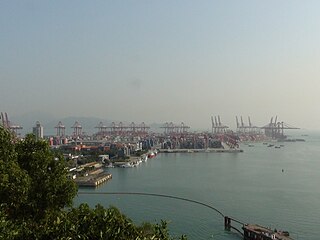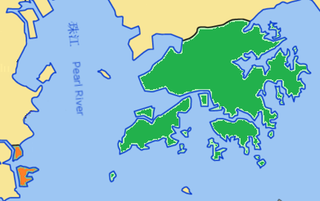Related Research Articles

A pearl is a hard, glistening object produced within the soft tissue of a living shelled mollusk or another animal, such as fossil conulariids. Just like the shell of a mollusk, a pearl is composed of calcium carbonate in minute crystalline form, which has deposited in concentric layers. The ideal pearl is perfectly round and smooth, but many other shapes, known as baroque pearls, can occur. The finest quality of natural pearls have been highly valued as gemstones and objects of beauty for many centuries. Because of this, pearl has become a metaphor for something rare, fine, admirable and valuable.

Oyster is the common name for a number of different families of salt-water bivalve molluscs that live in marine or brackish habitats. In some species, the valves are highly calcified, and many are somewhat irregular in shape. Many, but not all oysters, are in the superfamily Ostreoidea.

The Orient is a term referring to the East in relation to Europe, traditionally comprising anything belonging to the Eastern world. It is the antonym of the term Occident, which refers to the Western world.
The ecology of Hong Kong is mostly affected by the results of climatic changes. Hong Kong's climate is seasonal due to alternating wind direction between winter and summer.

The Pearl River Delta Metropolitan Region is the low-lying area surrounding the Pearl River estuary, where the Pearl River flows into the South China Sea. Referred to as the Guangdong-Hong Kong-Macao Greater Bay Area in official documents, the region is one of the most densely populated and urbanized regions in the world, and is considered a megacity by numerous scholars. It is currently the wealthiest region in Southern China and one of the wealthiest regions in China along with the Yangtze River Delta in Eastern China and Jingjinji in Northern China. Most of the region is part of the Pearl River Delta Economic Zone, which is a special economic zone of China.

Victoria Harbour is a natural landform harbour in Hong Kong separating Hong Kong Island in the south from the Kowloon Peninsula to the north. The harbour's deep, sheltered waters and strategic location on South China Sea were instrumental in Hong Kong's establishment as a British colony in 1841 and its subsequent development as a trading centre.

Jiangmen, alternately romanized in Cantonese as Kongmoon, is a prefecture-level city in Guangdong Province in southern China. It consists of three urban districts, Heshan, and the more rural Siyi, which is the ancestral homeland of approximately 4 million overseas Chinese. As of the 2020 census, the entire prefecture has a total population of about 4,798,090 inhabitants; its urban region has 2,657,062 inhabitants, which can also be considered part of the Guangzhou–Shenzhen metro conurbation with 65,565,622 inhabitants.

The eastern oyster —also called the Atlantic oyster, American oyster, or East Coast oyster—is a species of true oyster native to eastern North and South America. Other names in local or culinary use include the Wellfleet oyster, Virginia oyster, Malpeque oyster, Blue Pointoyster, Chesapeake Bay oyster, and Apalachicola oyster. C. virginica ranges from northern New Brunswick south through parts of the West Indies to Venezuela. It is farmed in all of the Maritime provinces of Canada and all Eastern Seaboard and Gulf states of the United States, as well as Puget Sound, Washington, where it is known as the Totten Inlet Virginica. It was introduced to the Hawaiian Islands in the 19th century and is common in Pearl Harbor.

The Pearl and Hermes Atoll, also known as Pearl and Hermes Reef, is part of the Northwestern Hawaiian Islands, a group of small islands and atolls that form the farthest northwest portion of the Hawaiian island chain. The atoll consists of a variable number of flat and sandy islets, typically between five and seven. More were noted in historical sources but have since been lost to erosion and rising sea levels.

Hoi Ha Wan or Jone's Cove is a bay at the north of Sai Kung Peninsula. It is part of Hoi Ha Wan Marine Park, a marine park in Hong Kong. The village of Hoi Ha is located on the innermost shore of Hoi Ha Wan.

Cultured pearls are pearls which are formed within a cultured pearl sac with human intervention in the interior of productive living molluscs in a variety of conditions depending upon the mollusc and the goals. Having the same material as natural pearls, cultured pearls can be cultivated in seawater or freshwater bodies. Over 95% of the pearls available on the market are cultured pearls.

Tolo Harbour, or Tai Po Hoi is a sheltered harbour in northeast New Territories of Hong Kong.

Pearl hunting, also known as pearling, is the activity of recovering or attempting to recover pearls from wild molluscs, usually oysters or mussels, in the sea or freshwater. Pearl hunting was prevalent in the Persian Gulf region and Japan for thousands of years. On the northern and north-western coast of Western Australia pearl diving began in the 1850s, and started in the Torres Strait Islands in the 1860s, where the term also covers diving for nacre or mother of pearl found in what were known as pearl shells.

Out of the total 1,092 km2 land in Hong Kong, three-quarters is countryside, with various landscapes including beaches, woodlands, and mountain ranges being found within the small territory. Most of Hong Kong's parks have abundant natural diversity, usually containing over 1,000 species of plants.
Oyster farming is an aquaculture practice in which oysters are bred and raised mainly for their pearls, shells and inner organ tissue, which is eaten. Oyster farming was practiced by the ancient Romans as early as the 1st century BC on the Italian peninsula and later in Britain for export to Rome. The French oyster industry has relied on aquacultured oysters since the late 18th century.

Lions Nature Education Centre is a facility situated on 34 hectares of land to the east of Hiram's Highway near Sai Kung Town, Hong Kong used for the purposes of public education, recreation, nature conservation and scientific studies. The centre includes many informative and attractive field and outdoor display areas, such as an arboretum, a rocks and mineral garden, a medicinal plants garden, a demonstration tree nursery, an insectarium and a shell house.
The Jane Goodall Institute (Hong Kong) (Chinese: 國際珍古德(香港)協會), founded in 2002, was established as a local registered charity involved in the promotion of the well-being of the community, animals and environment. The Jane Goodall Institute Hong Kong is one of the Asian branches of the Jane Goodall Institute which was founded in 1977 in California by Jane Goodall and Genevieve, Princess di San Faustino. With its headquarters in the US, the Jane Goodall Institute is a worldwide non-profit organization with 17 overseas offices.

The Port of Shenzhen is the collective name of a number of ports the coastline of Shenzhen, Guangdong Province, China. These ports as a whole form one of the busiest and fastest growing container ports in the world.

Hong Kong–Macau relations refers to bilateral relations between Hong Kong and Macau.

Hong Kong–Namibia relations refers to the international relations between Hong Kong and Namibia.